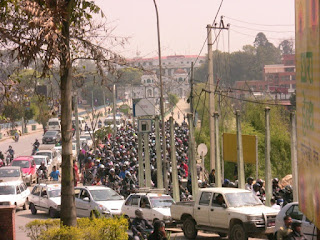As I write this article there are few buses with enough petrol to run. Yes, there is gas being brought in, but in such small quantities that even the rescue helicopters are not flying. I’m fortunate to be in a farming village in the Kathmandu Valley because few buses are bringing supplies to anywhere. They are so packed people are riding on the roofs and hanging onto the back. There aren’t many on the road anymore and we are just waiting for someone to make all this craziness go away. This picture was taken in 2012 during another fuel crisis, but this time the cars and motorcycles are just parked and abandoned for miles.
The sad thing is that we finally got the constitution the Nepali have been waiting so many years for. Now it is clear why it’s taken so long to get. India wouldn’t allow it, but finally they did it and the people were happy, at least the people I know. I try to stay out of politics because it isn’t my issue. I am a guest in this lovely country hope I don't over-step my place here.
I don’t know what I will do if it lasts beyond these couple weeks of cooking fuel, but by that time if it doesn’t end there will be few choices left. I won’t be able to leave and there will be little food for those outside the Valley. But I’ll be fine.
Why is this happening? Apparently, the unofficial word on the street, India wanted the Nepal constitution to reflect India’s needs better. They actually wanted to have the new constitution include a proviso that an Indian man can marry a Nepali woman and be able to run for prime minister. So, what can the people of Nepal do? Nothing. What can the government do? Nothing.
I was hoping Nepal would open up fuel trade with China, but there are some monopoly issues around the petrol supplier and some trade stuff with India.
This issue is complicated, indeed, but it boils down to a couple of facts: Nepal is quite small, Nepal is landlocked with two giants at its borders and India has been at the source of much of the problems. Nepal doesn’t stand a chance against these giants and neither SAARC, nor the UN, seem to want to deal with what’s actually going on. It’s a war on an unarmed nation.People are dying. Hospitals are running out of petrol for things like oxygen and so much more.
However, India is managing to bring in fruit and vegetables that are sitting in Kathmandu starting to rot because they cannot get anywhere. So, how is this situation due to Nepali rioting in the streets? What the media is saying is the blockade is caused by Nepali at the border towns. What they don't say is that the rioters (in one small region of Nepal) are mostly of Indian origin and are getting paid by India's political parties to keep it up.
Prior to the constitution being signed, there were problems in some regions of Nepal where the people wanted special recognition of their caste like their district would be the Mugar, Sherpa or Chhetri district (These are just examples of caste names; I don't know the actual castes wanting their own districts).
What can we do? I'm happy we have an NGO now because it makes it so much easier to get people to listen and do. What I am doing bringing solar cooking stoves and ovens to our village. We have 6 months of sunlight without clouds or rainy days. This could actually be a good thing, well, maybe a bad thing with some adjustments that will help us all in the long run.
Any volunteers who would like to come build shelters or help us with the solar cooking project please come. We always have enough to share, even though showers and laundry will be limited. Please note: We've had to start charging the normal volunteer charge of $5 a day due to the damage to the guest house and missing and broken things. I think it's best this way, anyway, so as not to take a volunteer from another NGO.
 | |
| We've been making rectangle shelters, but these look interesting, too, and maybe a little less expensive. |
Tags
India fuel blockade 2015
Nepal fuel crisis 2015
Nepal India relations
Visit nepal
visit nepal 2020

